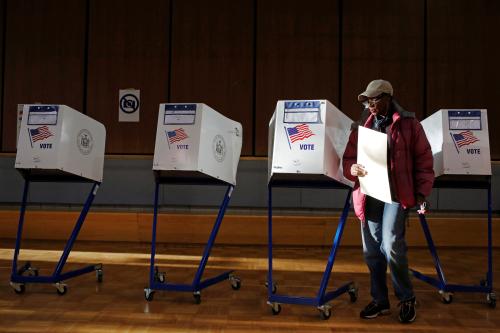Voters across the country elected hundreds of new state officials last November, including 20 new governors. With these new governors now sworn into office, the early public actions of many indicate that issues of economic innovation and inclusion will be key policy priorities in their first terms.
On economic innovation, digital technologies are changing the skills workers use each day, upending industries, and reshaping the ways that we communicate, travel, learn, and live. Accordingly, forward-looking governors have unveiled plans to transform state government operations using data and technology and to equip residents with the digital skills they need.
At the same time, those innovation dynamics are creating pressing economic inclusion challenges. Income growth has slowed for lower- and middle-class workers yet risen quickly for affluent ones; racial wealth disparities have widened; and entire regions of the country have been left behind, as our Brookings colleagues recently documented. As a result, more governors are placing issues of economic inclusion at the center of policy and budget decision-making.
Based on our review of inaugural addresses and initial executive orders, here are some of the new governors’ boldest ideas on economic innovation and inclusion:
Ohio Governor Mike DeWine has created a new office to modernize government services, increase the pipeline of teachers who code, and fund the completion of 10,000 industry certificates
Governor DeWine has launched InnovateOhio, an office that aims to implement new technologies across state agencies, and has appointed his Lieutenant Governor Jon Husted to chair it. As DeWine articulated during his campaign, InnovateOhio will take on a far-ranging set of activities, including requiring state departments to digitalize records and share data. InnovateOhio will also support efforts to strengthen computer science education among teachers, and fund training for at least 10,000 certificates for in-demand skills like coding and business analytics.
Maine Governor Janet Mills is creating an “Office of Innovation and the Future”
Citing Kurt Vonnegut’s advice that “Every government ought to have a Department of the Future,” Governor Mills announced plans to create an explicitly future-looking office in her inaugural address. Mills stated, “We know that someday, robots, drones, driverless cars, broadband, and 3-D printing, will radically alter the way Maine people live, learn, and work… This office will dive into major policy challenges, foster collaboration and propose concrete, workable solutions.” While public details are scant on this office’s leadership, mandate, and location within Maine’s state government structure, it represents a potential departure for a state that has long been known for less technology-intensive industries like timbering, fishing, and tourism.
California Governor Gavin Newsom proposes a “Marshall Plan” for affordable housing
In a budget address, Governor Newsom placed California’s affordable housing challenges at the forefront. His proposals include $500 million to combat homelessness, $500 million for middle-income housing construction, a quintupling of funds available for the state’s low-income housing tax credit, and $500 million to award cities and counties that meet short-term housing goals. Interestingly, his pledge to work with cities to build more housing has come with a threat: Newsom has suggested that he would withhold transportation or other state funding from cities that failed to meet construction targets. While this hardball tactic may not be a model for state-local collaboration, it could dramatically change the incentives that have stymied new construction in the state’s infamously unaffordable metro areas.
Minnesota Governor Tim Walz created a “One Minnesota Council on Diversity, Inclusion, and Equity”
In his first official action in office, Governor Walz established a council to consider how state government can support inclusion. The governor chairs this council, signaling its high priority level, and pledged that the council will inform both policy and budget decisions. While his predecessor made diverse hiring a priority, Walz, who represented a largely rural district in southern Minnesota in Congress for more than a decade, intends for the council to promote geographic inclusion as well. In Minnesota, as in many other states across the country, many rural communities have declining populations, lower median wages, and less diversified economies compared with urban areas.
Michigan Governor Gretchen Whitmer issued an executive directive to buy from “geographically disadvantaged businesses”
One of Governor Whitmer’s first 10 executive directives focused squarely on closing geographic disparities. Directive 8 ordered the state’s Department of Technology, Management, and Budget to “increase purchases from … Geographically Disadvantaged Business Enterprises,” including by granting preference to businesses in disadvantaged areas, reducing procurement barriers for these businesses, and meeting a goal of spending at least 3 percent of total state expenditures on these businesses by 2022.
It’s difficult to say what the full effect of these ideas will be. Yet they are unique responses to the numerous challenges that state leaders face, including an economy that produces extraordinarily unequal outcomes and new technologies that are fundamentally transforming our daily lives. These ideas may well inspire similar policies in other states—and perhaps at the national and local levels—in the years ahead.
The Brookings Institution is committed to quality, independence, and impact.
We are supported by a diverse array of funders. In line with our values and policies, each Brookings publication represents the sole views of its author(s).








Commentary
Five bold ideas from new governors on economic innovation and inclusion
January 23, 2019